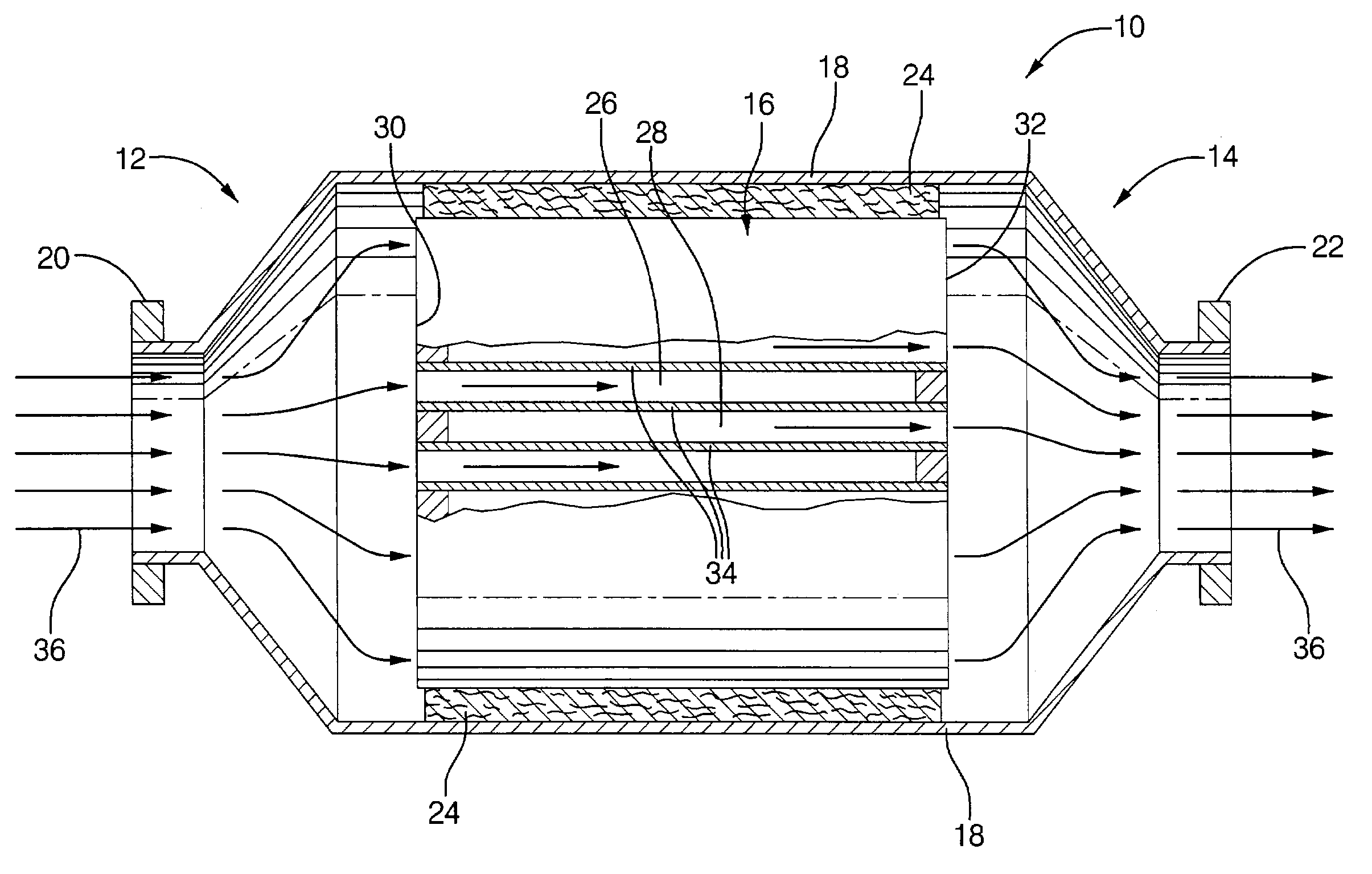Method for control of washcoat distribution along channels of a particulate filter substrate
a technology of filter substrate and washcoat, which is applied in the direction of physical/chemical process catalyst, separation process, metal/metal-oxide/metal-hydroxide catalyst, etc., can solve the problems of increased flow restriction, increased exhaust line backpressure, and detrimental to engine performance and fuel economy
- Summary
- Abstract
- Description
- Claims
- Application Information
AI Technical Summary
Benefits of technology
Problems solved by technology
Method used
Image
Examples
example 1
Sample A—A Particulate Filter Substrate Having an Evenly Coated Washcoat Throughout the Inlet Channels
[0022]To evenly load washcoat throughout the inlet channels of the particulate filter substrate, an amount of washcoat slurry and its solid content is selected to allow an even number of applications, with each application having slurry fully forced into the inlet channels of the particulate filter (100% of L). In the first application, the washcoat slurry is fully forced into the inlet channels via the inlet end of the filter substrate. A first clearing is then accomplished by applying a vacuum to the outlet end of the filter substrate such that the vacuum draws the washcoat slurry in the same direction that it was forced into to the particulate filter substrate. Next, the particulate filter substrate is flipped and the vacuum is applied to the inlet end to draw the excess washcoat slurry in an opposite direction, toward the inlet end. An isoscan of a particulate filter substrate i...
example 2
Sample B—Washcoat Loading Biased Towards the Inlet End of the Inlet Channels
[0023]Loading more washcoat at the inlet end of the inlet channels can be achieved by forcing slurry only partially into the inlet channels of the particulate filter substrate (e.g., 50% of L), followed by application of vacuum to the inlet end. The washcoat gradient (i.e., arrangement of catalytically active material) is generated with higher washcoat loading toward the inlet end. Sample B in FIG. 2 demonstrates a particulate filter substrate having a coating formed by this process using a 50% slurry filling (50% of L). As can be seen in FIG. 2 at Sample B, there is almost no washcoat near the outlet end of the particulate filter substrate.
example 3
Sample C—Washcoat Loading Biased Towards the Outlet End of the Inlet Channels of the Particulate Filter Substrate
[0024]Loading more washcoat toward the outlet end of the inlet channels can be achieved by using one-pass application and 100% slurry fill (100% of L). In the application, the washcoat slurry is fully forced into the inlet channels via the inlet end of the filter substrate. A vacuum is then applied to the outlet end of the filter substrate, followed by applying vacuum to the inlet end, causing the slurry to move towards the outlet end. Sample C in FIG. 2 demonstrates a particulate filter substrate having a coating formed by this process. As can be seen in FIG. 2 at Sample C, there is almost no washcoat near the inlet end of the particulate filter substrate.
PUM
| Property | Measurement | Unit |
|---|---|---|
| Length | aaaaa | aaaaa |
| Time | aaaaa | aaaaa |
| Distance | aaaaa | aaaaa |
Abstract
Description
Claims
Application Information
 Login to View More
Login to View More - R&D
- Intellectual Property
- Life Sciences
- Materials
- Tech Scout
- Unparalleled Data Quality
- Higher Quality Content
- 60% Fewer Hallucinations
Browse by: Latest US Patents, China's latest patents, Technical Efficacy Thesaurus, Application Domain, Technology Topic, Popular Technical Reports.
© 2025 PatSnap. All rights reserved.Legal|Privacy policy|Modern Slavery Act Transparency Statement|Sitemap|About US| Contact US: help@patsnap.com



